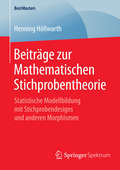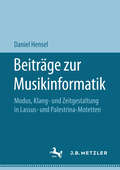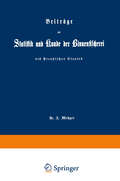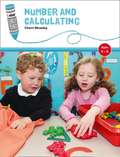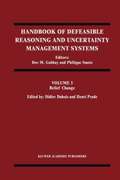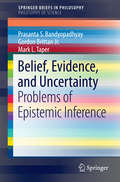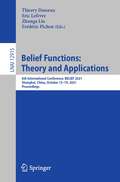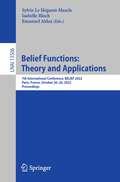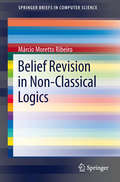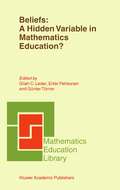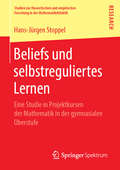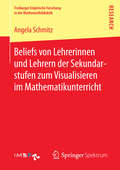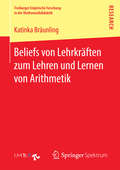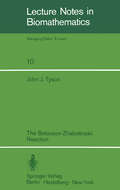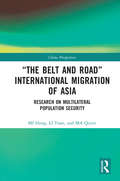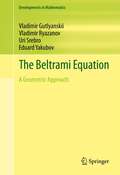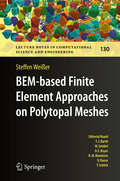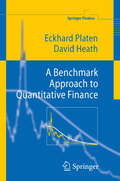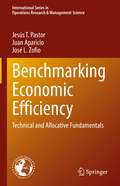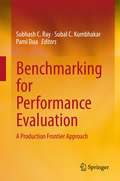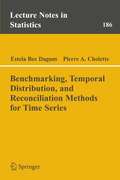- Table View
- List View
Beiträge zur Mathematischen Stichprobentheorie: Statistische Modellbildung mit Stichprobendesigns und anderen Morphismen (BestMasters)
by Henning HöllwarthHenning Höllwarth verbindet in seiner Arbeit die meist getrennt betrachteten Bereiche Stichprobentheorie und Mathematische Statistik. Begriffe, Konzepte und Resultate beider Fachgebiete werden hierzu präzisiert, verallgemeinert und in Beziehung gesetzt, sodass sich in der Konsequenz neue Aspekte der allgemeinen Mathematischen Statistik ergeben. Zur Veranschaulichung werden drei charakterlich vollkommen verschiedene Anwendungsfälle herangezogen, welche die Darstellung durchgehend begleiten und begründen.
Beiträge zur Musikinformatik: Modus, Klang- und Zeitgestaltung in Lassus- und Palestrina-Motetten
by Daniel HenselDaniel Hensels Studie bietet einen völlig neuen Blick auf die Entwicklung der Tonalität. Es wurden neben einfachen statistischen Verfahren spezielle Klanganalyse-Visualisierungen erarbeitet, die die Entwicklung der Klangqualität in ihrer zeitlichen Ausprägung über ganze Werkgruppen hinweg darstellen können. Ziel war es herauszufinden, wie sehr die Modi die Harmonik determinieren, ob sie sich statistisch voneinander unterscheiden und sich dadurch in ihrer Existenz beweisen lassen. Hierfür entwickelte der Autor zusammen mit dem Informatiker Ingo Jache den PALESTRiNIZER. Mit ihm untersuchte er die Möglichkeiten der computergestützten automatisierten Musikanalyse anhand des Verhältnisses von Modus und Klang in 253 Motetten von Lassus und Palestrina.
Beiträge zur Strukturtheorie der Grothendieck-Räume: Vorgelegt in der Sitzung vom 6. Juli 1985 von Helmut H. Schaefer (Sitzungsberichte der Heidelberger Akademie der Wissenschaften #1985 / 4)
by Frank RäbigerBelair: Early Years - Number And Calculating: Ages 3-5 (Belair: Early Years Ser.)
by Cherri MoseleyNumber and Calculating is packed with flexible ideas for developing early understanding and igniting curiosity in the Mathematics area of learning. Activities across fifteen themes can be tailored to meet the needs and interests of every child and support progress towards attaining the knowledge and skills required by the Early Learning Goals.
Belief and Counterfactuals: A Study in Means-End Philosophy
by Franz HuberThis is the first of two volumes on belief and counterfactuals. It provides an introduction to ranking theory, which is a powerful formal theory with a broad range of applications in different areas of analytic philosophy. Drawing on formal logic, ranking theory can account for degrees of belief, which can change with the introduction of new information. In Belief and Counterfactuals, Franz Huber applies ranking theory and belief revision to metaphysics and epistemology. Though based on his technical writings, the volume is intended to be as accessible as possible, in order to fully present the utility of ranking theory to a wide range of philosophical issues. The volume contains several novel arguments, accounts, and applications--including the consistency argument for ranking theory, the conditional theory of conditional belief, as well as solutions to the problems of conceptual belief change, logical learning, and learning conditionals. Huber also presents a defense of the instrumentalist understanding of normativity, or rationality, and an argument for the thesis that there are only hypothetical imperatives and no categorical imperatives. His distinctive use of means-end philosophy as a unifying methodological approach establishes a treatment of philosophy as a normative discipline, and of philosophical problems as entangled with one another. This position also explains the importance of logic to philosophy, without devolving into a separate technical theory.
Belief and Counterfactuals: A Study in Means-End Philosophy
by Franz HuberThis is the first of two volumes on belief and counterfactuals. It provides an introduction to ranking theory, which is a powerful formal theory with a broad range of applications in different areas of analytic philosophy. Drawing on formal logic, ranking theory can account for degrees of belief, which can change with the introduction of new information. In Belief and Counterfactuals, Franz Huber applies ranking theory and belief revision to metaphysics and epistemology. Though based on his technical writings, the volume is intended to be as accessible as possible, in order to fully present the utility of ranking theory to a wide range of philosophical issues. The volume contains several novel arguments, accounts, and applications--including the consistency argument for ranking theory, the conditional theory of conditional belief, as well as solutions to the problems of conceptual belief change, logical learning, and learning conditionals. Huber also presents a defense of the instrumentalist understanding of normativity, or rationality, and an argument for the thesis that there are only hypothetical imperatives and no categorical imperatives. His distinctive use of means-end philosophy as a unifying methodological approach establishes a treatment of philosophy as a normative discipline, and of philosophical problems as entangled with one another. This position also explains the importance of logic to philosophy, without devolving into a separate technical theory.
Belief Change (Handbook of Defeasible Reasoning and Uncertainty Management Systems #3)
by Dov M. Gabbay Philippe SmetsBelief change is an emerging field of artificial intelligence and information science dedicated to the dynamics of information and the present book provides a state-of-the-art picture of its formal foundations. It deals with the addition, deletion and combination of pieces of information and, more generally, with the revision, updating and fusion of knowledge bases. The book offers an extensive coverage of, and seeks to reconcile, two traditions in the kinematics of belief that often ignore each other - the symbolic and the numerical (often probabilistic) approaches. Moreover, the work encompasses both revision and fusion problems, even though these two are also commonly investigated by different communities. Finally, the book presents the numerical view of belief change, beyond the probabilistic framework, covering such approaches as possibility theory, belief functions and convex gambles. The work thus presents a unified view of belief change operators, drawing from a widely scattered literature embracing philosophical logic, artificial intelligence, uncertainty modelling and database systems. The material is a clearly organised guide to the literature on the dynamics of epistemic states, knowledge bases and uncertain information, suitable for scholars and graduate students familiar with applied logic, knowledge representation and uncertain reasoning.
Belief, Evidence, and Uncertainty: Problems of Epistemic Inference (SpringerBriefs in Philosophy #0)
by Prasanta S. Bandyopadhyay Gordon Brittan Jr. Mark L. TaperThis work breaks new ground by carefully distinguishing the concepts of belief, confirmation, and evidence and then integrating them into a better understanding of personal and scientific epistemologies. It outlines a probabilistic framework in which subjective features of personal knowledge and objective features of public knowledge have their true place. It also discusses the bearings of some statistical theorems on both formal and traditional epistemologies while showing how some of the existing paradoxes in both can be resolved with the help of this framework.This book has two central aims: First, to make precise a distinction between the concepts of confirmation and evidence and to argue that failure to recognize this distinction is the source of certain otherwise intractable epistemological problems. The second goal is to demonstrate to philosophers the fundamental importance of statistical and probabilistic methods, at stake in the uncertain conditions in which for the most part we lead our lives, not simply to inferential practice in science, where they are now standard, but to epistemic inference in other contexts as well. Although the argument is rigorous, it is also accessible. No technical knowledge beyond the rudiments of probability theory, arithmetic, and algebra is presupposed, otherwise unfamiliar terms are always defined and a number of concrete examples are given. At the same time, fresh analyses are offered with a discussion of statistical and epistemic reasoning by philosophers. This book will also be of interest to scientists and statisticians looking for a larger view of their own inferential techniques.The book concludes with a technical appendix which introduces an evidential approach to multi-model inference as an alternative to Bayesian model averaging.
Belief Functions: 6th International Conference, BELIEF 2021, Shanghai, China, October 15–19, 2021, Proceedings (Lecture Notes in Computer Science #12915)
by Thierry Denœux Eric Lefèvre Zhunga Liu Frédéric PichonThis book constitutes the refereed proceedings of the 6th International Conference on Belief Functions, BELIEF 2021, held in Shanghai, China, in October 2021. The 30 full papers presented in this book were carefully selected and reviewed from 37 submissions. The papers cover a wide range on theoretical aspects on mathematical foundations, statistical inference as well as on applications in various areas including classification, clustering, data fusion, image processing, and much more.
Belief Functions: 7th International Conference, BELIEF 2022, Paris, France, October 26–28, 2022, Proceedings (Lecture Notes in Computer Science #13506)
by Sylvie Le Hégarat-Mascle Isabelle Bloch Emanuel AldeaThis book constitutes the refereed proceedings of the 7th International Conference on Belief Functions, BELIEF 2022, held in Paris, France, in October 2022.The theory of belief functions is now well established as a general framework for reasoning with uncertainty, and has well-understood connections to other frameworks such as probability, possibility, and imprecise probability theories. It has been applied in diverse areas such as machine learning, information fusion, and pattern recognition. The 29 full papers presented in this book were carefully selected and reviewed from 31 submissions. The papers cover a wide range on theoretical aspects on mathematical foundations, statistical inference as well as on applications in various areas including classification, clustering, data fusion, image processing, and much more.
Belief Revision in Non-Classical Logics (SpringerBriefs in Computer Science)
by Márcio Moretto RibeiroSince the advent of the Semantic Web, interest in the dynamics of ontologies (ontology evolution) has grown significantly. Belief revision presents a good theoretical framework for dealing with this problem; however, classical belief revision is not well suited for logics such as Description Logics.Belief Revision in Non-Classical Logics presents a framework which can be applied to a wide class of logics that include – besides most Description Logics such as the ones behind OWL – Horn Logic and Intuitionistic logic, amongst others. The author also presents algorithms for the most important constructions in belief bases. Researchers and practitioners in theoretical computing will find this an invaluable resource.
Beliefs: A Hidden Variable In Mathematics Education? (Mathematics Education Library #31)
by Gilah C. Leder Erkki Pehkonen Günter TörnerThis book focuses on aspects of mathematical beliefs, from a variety of different perspectives. Current knowledge of the field is synthesized and existing boundaries are extended. The volume is intended for researchers in the field, as well as for mathematics educators teaching the next generation of students.
Beliefs und selbstreguliertes Lernen: Eine Studie in Projektkursen der Mathematik in der gymnasialen Oberstufe (Studien zur theoretischen und empirischen Forschung in der Mathematikdidaktik)
by Hans-Jürgen StoppelHans-Jürgen Stoppel beschäftigt sich im Rahmen von Projektkursen der gymnasialen Oberstufe in Nordrhein-Westfalen mit der Entwicklung von epistemologischen Beliefs und selbstreguliertem Lernen von Schülerinnen und Schülern. Mithilfe von Mixed Methods untersucht er als Forscher und Lehrer über ein Schuljahr hinweg in Projektkursen zu Codierung und Kryptographie detailliert epistemologische Beliefs und ihre Veränderungen in Verbindung mit selbstreguliertem Lernen. Er beschreibt die Auffassung von Mathematik der Schülerinnen und Schüler als Komponente epistemologischer Beliefs im Hinblick auf die Definition von Mathematik, den Erwerb mathematischen Wissens und des mathematischen Verständnisses sowie die entsprechenden Veränderungen. Die Vertiefung des Kursthemas erlaubt es, die Ergebnisse auch zu Schlüssen auf den Übergang von der Schule zur Hochschule heranzuziehen.
Beliefs von Lehrerinnen und Lehrern der Sekundarstufen zum Visualisieren im Mathematikunterricht (Freiburger Empirische Forschung in der Mathematikdidaktik)
by Angela SchmitzAngela Schmitz analysiert die Überzeugungen und Ziele von Mathematiklehrkräften der Sekundarstufen I und II zum Visualisieren, einem wesentlichen Element des Betreibens von Mathematik. Sie untersucht die Sichtweisen der Lehrkräfte auf Visualisierung im Unterricht und inwiefern sich diese zwischen verschiedenen mathematischen Themengebieten unterscheiden. Dabei betrachtet die Autorin die Bruchrechnung, Algebra, Funktionen und Analysis und zeigt potenzielle Zusammenhänge zwischen den Beliefs von Lehrerinnen und Lehrern, verschiedenen Themengebieten und unterschiedlichen Überzeugungsfeldern auf.
Beliefs von Lehrkräften zum Lehren und Lernen von Arithmetik (Freiburger Empirische Forschung in der Mathematikdidaktik)
by Katinka BräunlingKatinka Bräunling untersucht subjektive Vorstellungen von Lehrkräften in Bezug auf den mathematischen Teilbereich der Arithmetik. Ausgehend davon, dass diese Vorstellungen (Beliefs) von Lehrerinnen und Lehrern für ihre Unterrichtsplanung und ihr Handeln im Unterricht relevant sind, stellt die Autorin die Identifikation von Beliefs und Beliefsystemen in den Mittelpunkt der empirischen Studie. In einem Mixed-Method-Design analysiert sie qualitativ und quantitativ erhobene Daten angehender und erfahrener Lehrkräfte und setzt deren Beliefsysteme in Beziehung zueinander. Dabei werden diese Systeme in ihrer Struktur, ihrer längerfristigen Entwicklung sowie in Bezug auf ihre Handlungsrelevanz betrachtet.
The Belousov-Zhabotinskii Reaction (Lecture Notes in Biomathematics #10)
by J.J. TysonIn 1958 B. P. Belousov discovered that the oxidation of citric acid by bromate in the presence of cerium ions does not proceed to equilibrium methodically and uniformly, like most chemical reactions, but rather oscillates with clocklike precision between a yellow and colorless state. See Fig. 11. 1, p. 30. A. M. Zhabotinskii followed up on Belousov's original observation and in 1964 his first investigations appeared in the Russian journal Biofizika. Though H. Degn (in Copenhagen at the time) knew of Zhabotinskii's work and published his own account of the mechanism of oscillation in Nature (1967), this interesting reaction attracted little attention among Western scientists until 1968, when Zhabotinskii and his coworkers and Busse (from Braunschweig, W. Germany) reported on their work at an international conference on biological and biochemical oscillators held in Prague. Shortly thereafter appeared· a flurry of papers on temporal oscillations and spatial patterns in this reaction system. Vavilin and Zhabotinskii (1969) [and later Kasperek and Bruice (1971)] studied the kinetics of the oxidation 3 of Ce+ by Br0 and the oxidation of organic species by Ce+4. Busse (1969) 3 reported his observation of colored bands of chemical activity propagating up and down in a long tube of unstirred solution. Zaikin and Zhabotinskii (1970) observed circular chemical waves in thin layers of solution.
“The Belt and Road” International Migration of Asia: Research on Multilateral Population Security (China Perspectives)
by MI Hong LI Yuan MA QiyiniThe book studies multilateral population security issues and relevant governance strategies caused by international migration in the countries impacted by China’s Belt and Road initiative and their border areas.Buttressed by solid data mining and policy analysis, the title looks into the demographic trends of international migration in China and some Asian Belt and Road countries and stresses the urgency for more effective governance practices. Seeking to address the population security crisis triggered by the Initiative, the authors propose the idea of “multilateral population security governance”, grounded in the real-world challenges facing Belt and Road countries while also drawing on experiences of migration governance in western countries. As a new governance model, it calls for cross-border joint action and takes into consideration pertinent factors including economy, politics, culture, religion and commerce. Several case studies and comparative studies are offered in the chapters to illuminate the significance and effect of this cooperative mechanism.The book will be of interest to researchers and government officials interested in non-traditional security, international migration and formal demography as well as topics on population, resources and environment.
“The Belt and Road” International Migration of Asia: Research on Multilateral Population Security (China Perspectives)
by MI Hong LI Yuan MA QiyiniThe book studies multilateral population security issues and relevant governance strategies caused by international migration in the countries impacted by China’s Belt and Road initiative and their border areas.Buttressed by solid data mining and policy analysis, the title looks into the demographic trends of international migration in China and some Asian Belt and Road countries and stresses the urgency for more effective governance practices. Seeking to address the population security crisis triggered by the Initiative, the authors propose the idea of “multilateral population security governance”, grounded in the real-world challenges facing Belt and Road countries while also drawing on experiences of migration governance in western countries. As a new governance model, it calls for cross-border joint action and takes into consideration pertinent factors including economy, politics, culture, religion and commerce. Several case studies and comparative studies are offered in the chapters to illuminate the significance and effect of this cooperative mechanism.The book will be of interest to researchers and government officials interested in non-traditional security, international migration and formal demography as well as topics on population, resources and environment.
The Beltrami Equation: A Geometric Approach (Developments in Mathematics #26)
by Vladimir Gutlyanskii Vladimir Ryazanov Uri Srebro Eduard YakubovThis book is devoted to the Beltrami equations that play a significant role in Geometry, Analysis and Physics and, in particular, in the study of quasiconformal mappings and their generalizations, Riemann surfaces, Kleinian groups, Teichmuller spaces, Clifford analysis, meromorphic functions, low dimensional topology, holomorphic motions, complex dynamics, potential theory, electrostatics, magnetostatics, hydrodynamics and magneto-hydrodynamics.The purpose of this book is to present the recent developments in the theory of Beltrami equations; especially those concerning degenerate and alternating Beltrami equations. The authors study a wide circle of problems like convergence, existence, uniqueness, representation, removal of singularities, local distortion estimates and boundary behavior of solutions to the Beltrami equations. The monograph contains a number of new types of criteria in the given problems, particularly new integral conditions for the existence of regular solutions to the Beltrami equations that turned out to be not only sufficient but also necessary.The most important feature of this book concerns the unified geometric approach based on the modulus method that is effectively applied to solving the mentioned problems. Moreover, it is characteristic for the book application of many new concepts as strong ring solutions, tangent dilatations, weakly flat and strongly accessible boundaries, functions of finite mean oscillations and new integral conditions that make possible to realize a more deep and refined analysis of problems related to the Beltrami equations. Mastering and using these new tools also gives essential advantages for the reader in the research of modern problems in many other domains. Every mathematics graduate library should have a copy of this book.
BEM-based Finite Element Approaches on Polytopal Meshes (Lecture Notes in Computational Science and Engineering #130)
by Steffen WeißerThis book introduces readers to one of the first methods developed for the numerical treatment of boundary value problems on polygonal and polyhedral meshes, which it subsequently analyzes and applies in various scenarios. The BEM-based finite element approaches employs implicitly defined trial functions, which are treated locally by means of boundary integral equations. A detailed construction of high-order approximation spaces is discussed and applied to uniform, adaptive and anisotropic polytopal meshes. The main benefits of these general discretizations are the flexible handling they offer for meshes, and their natural incorporation of hanging nodes. This can especially be seen in adaptive finite element strategies and when anisotropic meshes are used. Moreover, this approach allows for problem-adapted approximation spaces as presented for convection-dominated diffusion equations. All theoretical results and considerations discussed in the book are verified and illustrated by several numerical examples and experiments. Given its scope, the book will be of interest to mathematicians in the field of boundary value problems, engineers with a (mathematical) background in finite element methods, and advanced graduate students.
A Benchmark Approach to Quantitative Finance (Springer Finance)
by Eckhard Platen David HeathA framework for financial market modeling, the benchmark approach extends beyond standard risk neutral pricing theory. It permits a unified treatment of portfolio optimization, derivative pricing, integrated risk management and insurance risk modeling. This book presents the necessary mathematical tools, followed by a thorough introduction to financial modeling under the benchmark approach, explaining various quantitative methods for the fair pricing and hedging of derivatives.
Benchmarking Economic Efficiency: Technical and Allocative Fundamentals (International Series in Operations Research & Management Science #315)
by Jesús T. Pastor Juan Aparicio José L. ZofíoThis book unifies and extends the definition and measurement of economic efficiency and its use as a real-life benchmarking technique for actual organizations. Analytically, the book relies on the economic theory of duality as guiding framework. Empirically, it shows how the alternative models can be implemented by way of Data Envelopment Analysis. An accompanying software programmed in the open-source Julia language is used to solve the models. The package is a self-contained set of functions that can be used for individual learning and instruction. The source code, associated documentation, and replication notebooks are available online. The book discusses the concept of economic efficiency at the firm level, comparing observed to optimal economic performance, and its decomposition according to technical and allocative criteria. Depending on the underlying technical efficiency measure, economic efficiency can be decomposed multiplicatively or additively. Part I of the book deals with the classic multiplicative approach that decomposes cost and revenue efficiency based on radial distance functions. Subsequently, the book examines how these partial approaches can be expanded to the notion of profitability efficiency, considering both the input and output dimensions of the firm, and relying on the generalized distance function for the measurement of technical efficiency. Part II is devoted to the recent additive framework related to the decomposition of economic inefficiency defined in terms of cost, revenue, and profit. The book presents economic models for the Russell and enhanced graph Russell measures, the weighted additive distance function, the directional distance function, the modified directional distance function, and the Hölder distance function. Each model is presented in a separate chapter. New approaches that qualify and generalize previous results are also introduced in the last chapters, including the reverse directional distance function and the general direct approach. The book concludes by highlighting the importance of benchmarking economic efficiency for all business stakeholders and recalling the main conclusions obtained from many years of research on this topic. The book offers different alternatives to measure economic efficiency based on a set of desirable properties and advises on the choice of specific economic efficiency models.
Benchmarking for Performance Evaluation: A Production Frontier Approach
by Subhash C. Ray Subal C. Kumbhakar Pami DuaThis book provides a detailed introduction to the theoretical and methodological foundations of production efficiency analysis using benchmarking. Two of the more popular methods of efficiency evaluation are Stochastic Frontier Analysis (SFA) and Data Envelopment Analysis (DEA), both of which are based on the concept of a production possibility set and its frontier. Depending on the assumed objectives of the decision-making unit, a Production, Cost, or Profit Frontier is constructed from observed data on input and output quantities and prices. While SFA uses different maximum likelihood estimation techniques to estimate a parametric frontier, DEA relies on mathematical programming to create a nonparametric frontier. Yet another alternative is the Convex Nonparametric Frontier, which is based on the assumed convexity of the production possibility set and creates a piecewise linear frontier consisting of a number of tangent hyper planes.Three of the papers in this volume provide a detailed and relatively easy to follow exposition of the underlying theory from neoclassical production economics and offer step-by-step instructions on the appropriate model to apply in different contexts and how to implement them. Of particular appeal are the instructions on (i) how to write the codes for different SFA models on STATA, (ii) how to write a VBA Macro for repetitive solution of the DEA problem for each production unit on Excel Solver, and (iii) how to write the codes for the Nonparametric Convex Frontier estimation. The three other papers in the volume are primarily theoretical and will be of interest to PhD students and researchers hoping to make methodological and conceptual contributions to the field of nonparametric efficiency analysis.
Benchmarking, Temporal Distribution, and Reconciliation Methods for Time Series (Lecture Notes in Statistics #186)
by Estela Bee Dagum Pierre A. CholetteTime series play a crucial role in modern economies at all levels of activity and are used by decision makers to plan for a better future. Before publication time series are subject to statistical adjustments and this is the first statistical book to systematically deal with the methods most often applied for such adjustments. Regression-based models are emphasized because of their clarity, ease of application, and superior results. Each topic is illustrated with real case examples. In order to facilitate understanding of their properties and limitations of the methods discussed a real data example is followed throughout the book.
